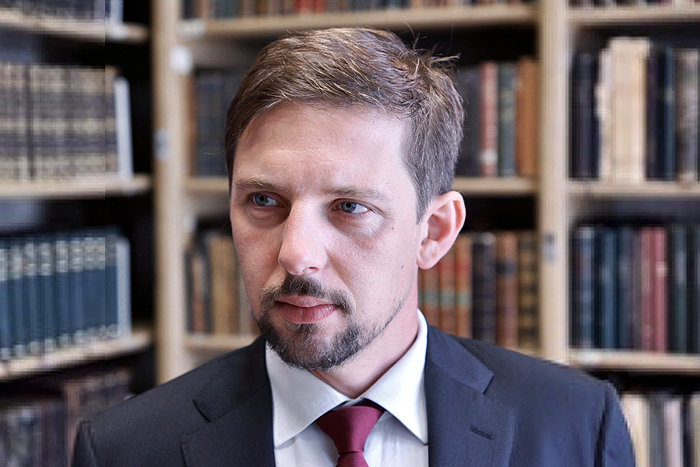During its meeting in September 2019, the Committee of Ministers of the Council of Europe set up an Ad Hoc Committee on Artificial Intelligence – CAHAI. The main task of the Committee, which held its first plenary meeting in November, is to examine the feasibility and potential elements of a legal framework for the development, design and application of artificial intelligence, based on the of broad multi-stakeholder consultations and Council of Europe’s standards on human rights, democracy and the rule of law. Gregor Strojin, President of the CAHAI, in his interview to RAPSI provides insight on the approach of the Council of Europe to regulation of artificial intelligence and the existing difficulties.
- Why the Council of Europe decided to turn its eyes on the problem of artificial intelligence today by establishing CAHAI? Why didn’t this happen, for instance, 5 years ago, when our interaction with AI became the «new norm» of our life?
- The recent decision of the Committee of Ministers to establish CAHAI is only one of the many steps that the Council of Europe, as an international organization comprising of 47 different member states, has taken over the past regarding emerging technologies.
What is now called AI by convenience is not a completely new technology. Although the term is experiencing a renewed interest and fashion, there are well-known issues related to the use of computers, informatics and data behind it. As such, the Council of Europe was not only active, but also a forerunner addressing many of the underlying or associated issues.
The Convention for protection of individuals with regard to the processing of personal data (Convention 108) was opened for signature already in 1981, and was the first international text on the subject and still remains relevant. 55 states have ratified it, some of which are beyond European borders. The Russian Federation signed it on 7 November 2001.
On 28 January 2019 the Consultative Committee of the Convention also published Guidelines on Artificial Intelligence and Data Protection.
Similarly, in the fight against cybercrime, where the automation of certain criminal acts already causes significant damage, the Convention on cybercrime (Budapest Convention) has provided a unique framework for judicial cooperation since 2001 and more than 60 countries have already ratified it.
Other binding instruments, such as the European Convention on Human Rights itself, or non-binding instruments such as in the field of education (with the Steering Committee for Educational Policy and Practice (CDPPE) and «Digital Civic Education»), justice (the European Charter for the Use of AI in Judicial Systems - a globally unique instrument adopted by CEPEJ in 2018) or the fight against information disorders, could also be mentioned.
At least 42 instruments from the Council of Europe, written or in the process of being written, dealing directly or indirectly with artificial intelligence were identified during the first plenary session of CAHAI.
The Council of Europe must now carry out a horizontal synthesis work in order to take advantage of this intense activity to define common denominators of action, simple and intelligible to all: this is exactly the mission of CAHAI in the context of its feasibility study.
- How do you plan to improve the legal framework for AI taking into account the need to keep the balance between rapid technological development, for which regulatory standards simply cannot keep up, and human rights protection issues?
- CAHAI's priorities are set out in its mandate: to examine the feasibility of a potential legal framework for the development, design and application of artificial intelligence, based on the Council of Europe's standards on human rights, democracy and the rule of law.
It seems important that the new legal instrument takes into account the impact of the new technological developments on individual rights enshrined in the European Convention on Human Rights (for instance, right to privacy and personal life, fair trial, freedom of expression, freedom of association, right to non-discrimination, etc.) as well as various impacts which can disrupt the functioning of democracy.
The question of rapid technological development is partly already answered by existing digital legal frameworks: Convention 108 and 108+ for example or the Convention on Cybercrime are technologically «neutral». They are not intended to limit a particular form of technology but rather to increase the protection of human rights in a digital environment. Regulation should not inhibit technological development, it should address its effects.
The CAHAI’s work and reflections on a legal framework and principles will not necessarily regulate specific technologies or methods (e.g., deep neural networks or any other form of machine learning, particular applications, etc.) but rather aim to prevent and address any harmful consequences of certain applications and their potential use, and also encourage developments that can have positive and synergic impact on human rights, the rule of law and democracy.
- The situation with regulation in the field of artificial intelligence is complicated by the lack of thorough information about how AI-based systems are designed, how they function, how they may change in the nearest future and how we are able to challenge these decisions in effective way. Stephen Hawking warned that as AI becomes smarter, it will be more difficult to control. How are you going to regulate the sphere in circumstances when developers don’t know what would happen tomorrow?
- It is not a question of regulating the future. The fact that we cannot predict the future should not paralyze any reflection on reality or detract from an objective analysis of contributions and risks. It is also not a question of regulating the technology. It is, however, a question of regulating its effects and of ensuring adequate oversight over methods of design, development and application. We must distinguish between perception of AI which was created by sci-fi, and its actual reality. Technology is not yet at a level of general AI, and although novel and increased capabilities disrupt traditional patterns and relations, most decisions and the ways of how it is developed and used ultimately still rely on humans.
It is true that transparency, or lack thereof, is a very relevant issue. Many standards and recommendations are already well known but are not binding. Their implementation in the design and development phases mainly depends on self-regulation, which in turn depends on adequate responsibility by developers and ex ante trust by users.
Parts of recent discourse on AI both in academic circles and in public institutions were also a reaction to various breaches of trust, some of which have even led to catastrophic results.
Experiences have already shown very concrete consequences with the use of certain categories of decision-making algorithms or through exploitation of its processing and pattern identifying probabilities. Discrimination in recruitment in companies or in trying to assess the risks of criminal recidivism, interference in electoral processes, deaths due to autonomous vehicles are already a reality.
The late Stephen Hawking also called for «employing best practice and effective management», and the Open letter on research priorities for robust and beneficial AI, which he signed, also called for addressing legal policy questions such as «verifiability of compliance, enforceability, ability to reduce risk, ability to avoid stifling desirable technology development, likelihood of being adopted, and ability to adapt over time to changing circumstances».
Some possible approaches to be considered by the CAHAI, for example, consider verification mechanisms similar to those known to the pharmaceutical industry, and preliminary human rights impact assessments for deployment of certain types of applications.
Such measures build trust with users, while ensuring that innovations can be reviewed for their compliance, even if they were not specifically considered by the regulator. Such measures could provide a real added value for business. In fact, they would provide a predictable, uniform framework for business operation (instead of small-scale, patchwork solutions), and also support the rise of an European robust and ethical, trustworthy industry, which would in turn provide a competitive advantage in respect of other international players.
- It’s common knowledge that highly specialized knowledge is required to regulate high-tech areas, especially when AI is applied. Does the committee plan to engage private sector professionals and civil society specialists as consultants and interact with such giants as Google, for example, in order to find the solutions? And if the answer is yes, how would you guarantee the regulatory framework isn’t flawed and biased and it doesn’t slow down the technologies’ development? In the end, tech giants might have their own view on the regulatory tools.
- CAHAI will indeed carry out multi-stakeholder consultations with as broad participation of actors who are involved in or pertinent to AI life-cycles as possible. In addition to member states and various international organizations this includes civil society, academia, as well as some major private sector technology companies and associations with which Council of Europe has had a partnership since November 2017.
Such consultations imply a direct and concrete dialogue, a sharing of views and a better understanding of mutual positions and constraints but do not give any prerogative to companies. They have their own observer status, which gives them no voting rights. The intergovernmental work therefore remains under full control of the 47 Member States, which have delegated high-level experts capable of making informed decisions on the directions to be taken.
- The expert community has come to a consensus that the integration of technologies based on AI can have an amazing effect on the society, e.g. the rule of law, human rights protection, democracy values. From this perspective, do you believe that the approach for introducing the regulatory framework should be cautious or, on the other hand, proactive?
- The Committee of Ministers of the Council of Europe seems to share this observation, since an initial feasibility study on a legal framework for the design, development and application of Artificial Intelligence is the very mandate of CAHAI. Caution and proactivity do not seem to be incompatible, however, and are even essential to prevent and forestall human rights violations.
The preliminary work of mapping existing legal instruments responds to the need not to rush and not to duplicate law where it already exists, thereby risking contradiction. On the other hand, the legal framework created may encourage Member States to be more proactive, as it is they who are primarily responsible for creation of conditions for the exercise and enjoyment of human rights and prevention of their violations. The lure of efficiency and effectiveness that the new technologies bring in many fields should not detract the states from carefully assessing their impact and proportionality of their effects in regard to the entire spectrum of human rights.
- Does CAHAI plan to issue some sort of recommendations and guidelines to cover education policy thereby motivating CE member states to develop the competencies of its citizens to engage positively with AI technologies and better understand their implications for our lives?
- CAHAI’s direction will depend on the decisions of its member states, which is why it is premature to speculate on specific outputs. It must be understood, however, that CAHAI’s work already fits into a wider context of Council of Europe’s activities, of which education, digital literacy and also democratic participation are already an important part.
Supporting children and young people to participate safely, effectively, critically and responsibly in a world filled with social media and digital technologies has emerged as priority for policy-makers and educators. Council of Europe’s guidelines to respect, protect and fulfil the rights of the child in the digital environment issued in 2018 are one concrete example, and they recall States’ duty to engage all relevant stakeholders in this context.
Also, the notion of digital citizenship has evolved to encompass a range of competences, attributes and behaviours that harness the benefits and opportunities the online world affords while building resilience to potential harms. To address the issue the Steering Committee for Educational Policy and Practice (CDPPE) of the Council of Europe launched a new intergovernmental project entitled «Digital Citizenship Education» in 2016. The aim of this project is to contribute to reshaping the role that education plays in enabling all children to acquire the competences they need as digital citizens to participate actively and responsibly in a democratic society, whether offline or online.
We believe that Council of Europe’s work on these issues will undoubtedly contribute to or complement usefully CAHAI’s outputs.
Interviewed by Nikita Korf, RAPSI.



